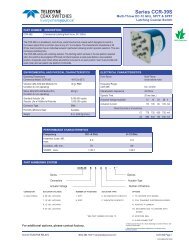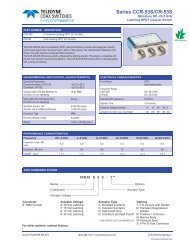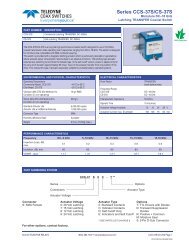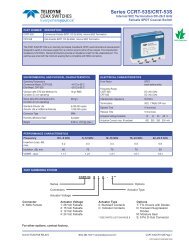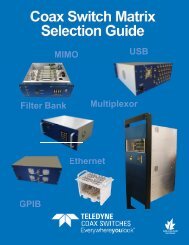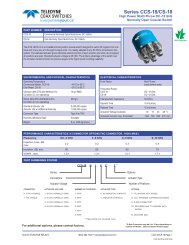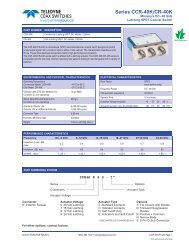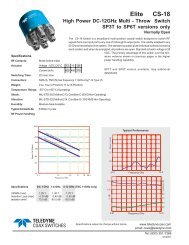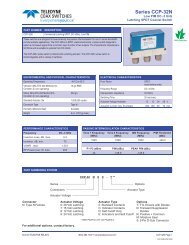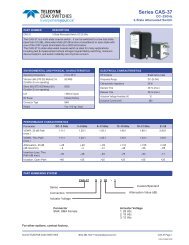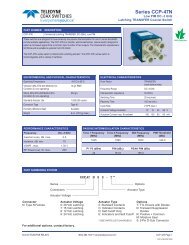Download our Space Databook - Teledyne Relays
Download our Space Databook - Teledyne Relays
Download our Space Databook - Teledyne Relays
You also want an ePaper? Increase the reach of your titles
YUMPU automatically turns print PDFs into web optimized ePapers that Google loves.
DETAILED SUMMARY OF STANDARD SCREENING<br />
Sinusoidal Vibration<br />
Random Vibration (If Specified)<br />
Particle Impact Noise Detection (PIND)<br />
Internal Moisture<br />
Thermal Cycle<br />
Miss Test (Run-in)<br />
<strong>Relays</strong> shall be tested in accordance with MIL-STD-202, method 204.<br />
The following details and exceptions shall apply: Mounting method:<br />
Rigidly mounted by normal mounting means. Test condition D, except<br />
vibration level is the lesser of 0.195 inch double amplitude or 30 G<br />
peak, unless otherwise specified (see 3.1) and the frequency range<br />
shall be 10 Hz to 3,000 Hz. Contacts monitored to detect contact<br />
chatter and transfer<br />
<strong>Relays</strong> shall be tested in accordance with MIL-STD-202, method 214.<br />
The following details and exceptions shall apply: Mounting method:<br />
Rigidly mounted by normal mounting means. Test condition: Table I,<br />
test condition G (0.4 G2 /Hz, 23.9 G r.m.s.). Conacts monitored to<br />
detect contact chatter and transfer.<br />
Each relay shall be subjected to a PIND test capable of<br />
detecting the presence of loose particles within the relay enclosure in<br />
accordance with the requirements of <strong>Teledyne</strong> <strong>Relays</strong>’ Procedure<br />
0-40-824, which must be approved by the Orderer. <strong>Relays</strong> so tested<br />
shall exhibit no evidence of loose particle contamination.<br />
<strong>Relays</strong> (coils de-energized) shall be at ambient room temperature<br />
prior to the start of test. The insulation resistance of all contact pins<br />
to case only shall be measured and observed. The relay coil shall be<br />
energized with 140 % of rated voltage for a period of 2½ minutes.<br />
For latching relays, this test shall be repeated for each coil. The<br />
insulation resistance of all contact pins to case only shall be verified<br />
a minimum of once each 30 seconds during this period.<br />
Each relay shall be subjected to 5 cycles of thermal shock in<br />
accordance with MIL-STD-202, Method 107, Test Condition B at the<br />
minimum and maximum rated temperatures (see 3.1). The following<br />
details and exceptions apply: The relay shall be de-energized during the<br />
first f<strong>our</strong> temperature conditioning cycles, and the coil continuity shall<br />
be monitored continuously during this time. Monitoring current shall not<br />
exceed 300 MA. The relay shall be de-energized during low<br />
temperature. Step one of each temperature cycle shall be high<br />
temperature; step 3 of each temperature cycle shall be low<br />
temperature. At the end of each temperature extreme during the fifth<br />
temperature cycle (Steps 1 and 3), each relay shall be tested as<br />
follows: Non-latching relays shall be energized with maximum rated<br />
coil voltage (see 3.1) for one h<strong>our</strong> minimum. At the end of this time and<br />
while still at the high temperature extreme, perform the following electrical<br />
measurements: insulation resistance (at high<br />
temperature only), static contact resistance, operating characteristics,<br />
operate and release time and contact bounce time. Following the<br />
electrical measurements, perform the miss test.<br />
During Step 4 of the fifth cycle, stabilize the relays at room ambient for<br />
a minimum of 1 h<strong>our</strong>, with the coil(s) de-energized.<br />
<strong>Relays</strong> shall be subjected to a 2,500 cycle run-in test at each of the<br />
applicable ambient temperatures. The following details apply: Coil<br />
energization conditions: The coil(s) shall be energized and cycled at<br />
maximum rated voltage (see 3.1). Cycling Rate: 1 to 5 Hz. Contact<br />
loading: <strong>Relays</strong> shall have the contacts loaded as follows: open circuit<br />
load voltage 10 to 50 mV d.c. or peak a.c., load<br />
current 10 to 50 μA Monitoring: The contact voltage drop or resistance<br />
for each pair of mated contacts shall be monitored during 40 %<br />
minimum of each “on” and each “off” period, within the latter 50 % of<br />
each period. The test equipment shall<br />
record all relay failures<br />
© 2013 <strong>Teledyne</strong> Coax Switches (800) 351-7368 • www.teledynerelays.com • +44 (0) 1236 453124 • www.teledyne-europe.com Page 31



